The Feeling of Safety by Pedestrians at Night: An Overlooked Aspect of Climate Change?
Abstract
:1. Introduction
2. Summary of Previous Studies
3. Conceptual Model of the Weather–FoS Relationship
4. Materials and Method
4.1. Data Collection Tool
4.2. Instrumental Measurements of Nighttime Illumination
4.3. Environmental Factors
4.4. Weather Attribute
4.5. Data Retrieval and Processing
4.6. Statistical Analysis
4.7. Research Hypotheses
5. Results
5.1. General Trends
5.2. Regression Modelling
5.3. Factors’ Contribution Test
6. Discussion
7. Conclusions
Author Contributions
Funding
Institutional Review Board Statement
Informed Consent Statement
Data Availability Statement
Conflicts of Interest
Appendix A


Appendix B

Appendix C
| Source | Tel Aviv-Yafo | Haifa | Beersheba | Israeli Average |
|---|---|---|---|---|
| Percent of respondents who reported feeling reasonable safe or very safe in this survey (%) | 77.0 | 76.0 | 68.0 | - |
| Crime index measured on a 100-point scale, from 0 (Low) to 100 (High) (Source: Numbeo, nd) | 26.74 | 26.66 | 47.11 | 32.22 |
| Percent of residents who report “feel safe after dark” in the nationwide survey (Source: CBSI, 2022) | 83.20 | 72.10 | 68.80 | 80.40 |
| Crimes reported to the Israeli police per 1000 residents in 2022—bodily harm and sex crimes only (Source: Israel Police, 2023) | 6.47 | 10.04 | 9.89 | - |
Appendix D
| Predictor | B | t-Value |
|---|---|---|
| Illumination | ||
| Illuminance—horizontal (Ln) | 0.355 | 37.593 *** |
| Relative humidity | ||
| RH | 0.010 | 10.676 *** |
| Locational and environmental factors | ||
| City dummies (ref. = Tel Aviv-Yafo) | ||
| Haifa | −0.121 | −4.079 *** |
| Beersheba | −0.359 | −11.158 *** |
| Traffic density (ref. = sparse traffic) | ||
| average traffic | 0.352 | 12.993 *** |
| heavy traffic | 0.377 | 11.119 *** |
| Vegetation (ref. = no vegetation) | ||
| sparse vegetation | −0.070 | −2.842 *** |
| dense vegetation | −0.192 | −5.279 *** |
| Individual level factors | ||
| Age group (ref. = 60+) | ||
| 18–40 yo (Age1) | −0.109 | −2.200 * |
| 40–59 yo (Age2) | 0.059 | 1.141 * |
| Gender (ref. = Male) | ||
| · Female | 0.490 | 6.674 *** |
| Interaction terms: | ||
| Age1 * Gender | −0.745 | −9.363 *** |
| Age2 * Gender | −0.600 | −7.121 *** |
| Education (years of schooling) | 0.027 | 6.914 *** |
| Country of birth (ref. = Israel) | ||
| other countries | 0.108 | 3.344 ** |
| Temporal factors | ||
| Day of the week (ref. = weekend) | ||
| weekday | −0.027 | −1.057 *** |
| Assessment time (ref. = after 22:00) | ||
| before 22:00 | 0.118 | 4.405 *** |
| Winter months (ref. = Oct.) | ||
| November | 0.551 | 10.676 *** |
| December | 0.444 | 9.752 *** |
| January | 0.206 | 3.657 *** |
| February | 0.553 | 8.593 *** |
| Summer months (ref. = Oct.) | ||
| May | −1.237 | −4.618 *** |
| Jun | 0.363 | 7.761 *** |
| July | −0.457 | −2.582 *** |
| Shoulder months (ref. = Oct.) | ||
| March | 0.771 | 7.568 *** |
| September | 0.143 | 2.828 *** |
| Intercepts | ||
| α1 (0|1) | −1.057 | −8.884 *** |
| α2 (1|2) | 0.996 | 8.501 *** |
| α3 (2|3) | 3.107 | 26.223 *** |
| Number of observations | 30,216 | |
| −2 log-likelihood | 34,289.240 | |
| AIC | 68,636.480 | |
References
- Maslow, A.H. Motivation and Personality; Harpers: Oxford, UK, 1954. [Google Scholar]
- Tay, L.; Diener, E. Needs and Subjective Well-Being around the World. J. Pers. Soc. Psychol. 2011, 101, 354–365. [Google Scholar] [CrossRef] [PubMed]
- Zheng, Z.; Gu, S.; Lei, Y.; Lu, S.; Wang, W.; Li, Y.; Wang, F. Safety Needs Mediate Stressful Events Induced Mental Disorders. Neural Plast. 2016, 2016, 8058093. [Google Scholar] [CrossRef]
- Saad, R.; Portnov, B.A.; Trop, T. Saving Energy While Maintaining the Feeling of Safety Associated with Urban Street Lighting. Clean. Technol. Environ. Policy 2021, 23, 251–269. [Google Scholar] [CrossRef]
- Loewen, L.J.; Steel, G.D.; Suedfeld, P. Perceived Safety from Crime in the Urban Environment. J. Environ. Psychol. 1993, 13, 323–331. [Google Scholar] [CrossRef]
- Portnov, B.A.; Saad, R.; Trop, T.; Kliger, D.; Svechkina, A. Linking Nighttime Outdoor Lighting Attributes to Pedestrians’ Feeling of Safety: An Interactive Survey Approach. PLoS ONE 2020, 15, e0242172. [Google Scholar] [CrossRef]
- Svechkina, A.; Portnov, B.A.; Trop, T. The Impact of Artificial Light at Night on Human and Ecosystem Health: A Systematic Literature Review. Landsc. Ecol. 2020, 35, 1725–1742. [Google Scholar] [CrossRef]
- Foster, S.; Giles-Corti, B.; Knuiman, M. Neighbourhood Design and Fear of Crime: A Social-Ecological Examination of the Correlates of Residents’ Fear in New Suburban Housing Developments. Health Place 2010, 16, 1156–1165. [Google Scholar] [CrossRef]
- Koszowski, C.; Gerike, R.; Hubrich, S.; Götschi, T.; Pohle, M.; Wittwer, R. Active Mobility: Bringing Together Transport Planning, Urban Planning, and Public Health. In Towards User-Centric Transport in Europe: Challenges, Solutions and Collaborations; Springer: Cham, Switzerland, 2019; pp. 149–171. [Google Scholar]
- European Environment Agency. Walking, Cycling and Public Transport in Cities Remain Greener Mobility Options than Electric Scooters or Car Ride-Hailing. Available online: https://www.eea.europa.eu/highlights/walking-cycling-and-public-transport (accessed on 30 October 2024).
- Yigitcanlar, T.; Kamruzzaman, M. Planning, Development and Management of Sustainable Cities: A Commentary from the Guest Editors. Sustainability 2015, 7, 14677–14688. [Google Scholar] [CrossRef]
- Panter, J.R.; Jones, A.P.; van Sluijs, E.M. Environmental Determinants of Active Travel in Youth: A Review and Framework for Future Research. Int. J. Behav. Nutr. Phys. Act. 2008, 5, 34. [Google Scholar] [CrossRef]
- Meerow, S.; Newell, J.P.; Stults, M. Defining Urban Resilience: A Review. Landsc. Urban. Plan. 2016, 147, 38–49. [Google Scholar] [CrossRef]
- Hodson, M.; Marvin, S. Urbanism in the Anthropocene: Ecological Urbanism or Premium Ecological Enclaves? City 2010, 14, 298–313. [Google Scholar] [CrossRef]
- Chen, C.; Zhao, X.; Liu, H.; Ren, G.; Liu, X. Influence of Adverse Weather on Drivers’ Perceived Risk during Car Following Based on Driving Simulations. J. Mod. Transp. 2019, 27, 282–292. [Google Scholar] [CrossRef]
- Lee, S.; Ha, M. The Duality of Visibility: Does Visibility Increase or Decrease the Fear of Crime in Schools′ Exterior Environments? J. Asian Archit. Build. Eng. 2015, 14, 145–152. [Google Scholar] [CrossRef]
- Di Tella, R.; Schargrodsky, E. Do Police Reduce Crime? Estimates Using the Allocation of Police Forces After a Terrorist Attack. Am. Econ. Rev. 2004, 94, 115–133. [Google Scholar] [CrossRef]
- Svechkina, A.; Trop, T.; Portnov, B.A. How Much Lighting Is Required to Feel Safe When Walking Through the Streets at Night? Sustainability 2020, 12, 3133. [Google Scholar] [CrossRef]
- Doleac, J.L.; Sanders, N.J. Under the Cover of Darkness: How Ambient Light Influences Criminal Activity. Rev. Econ. Stat. 2015, 97, 1093–1103. [Google Scholar] [CrossRef]
- Portnov, B.A.; Saad, R.; Trop, T. Interactive Scenario-Based Assessment Approach of Urban Street Lighting and Its Application to Estimating Energy Saving Benefits. Energies 2021, 14, 378. [Google Scholar] [CrossRef]
- Fotios, S.; Castleton, H. Specifying Enough Light to Feel Reassured on Pedestrian Footpaths. Leukos 2016, 12, 235–243. [Google Scholar] [CrossRef]
- Andrade, H.; Alcoforado, M.-J.; Oliveira, S. Perception of Temperature and Wind by Users of Public Outdoor Spaces: Relationships with Weather Parameters and Personal Characteristics. Int. J. Biometeorol. 2011, 55, 665–680. [Google Scholar] [CrossRef]
- Kaparias, I.; Bell, M.G.H.; Miri, A.; Chan, C.; Mount, B. Analysing the Perceptions of Pedestrians and Drivers to Shared Space. Transp. Res. Part. F Traffic Psychol. Behav. 2012, 15, 297–310. [Google Scholar] [CrossRef]
- Stathopoulos, T.; Wu, H.; Zacharias, J. Outdoor Human Comfort in an Urban Climate. Build. Environ. 2004, 39, 297–305. [Google Scholar] [CrossRef]
- Ranson, M. Crime, Weather, and Climate Change. J. Environ. Econ. Manag. 2014, 67, 274–302. [Google Scholar] [CrossRef]
- Baryshnikova, N.; Davidson, S.; Wesselbaum, D. Do You Feel the Heat around the Corner? The Effect of Weather on Crime. Empir. Econ. 2022, 63, 179–199. [Google Scholar] [CrossRef]
- Boomsma, C.; Steg, L. Feeling Safe in the Dark. Environ. Behav. 2014, 46, 193–212. [Google Scholar] [CrossRef]
- Yeoh, B.S.A.; Yeow, P.L. Where Women Fear to Tread: Images of Danger and the Effects of Fear of Crime in Singapore. GeoJournal 1997, 43, 273–286. [Google Scholar] [CrossRef]
- Blöbaum, A.; Hunecke, M. Perceived Danger in Urban Public Space. Environ. Behav. 2005, 37, 465–486. [Google Scholar] [CrossRef]
- Box, S.; Hale, C.; Andrews, G. Explaining Fear of Crime. Br. J. Criminol. 1988, 28, 340–356. [Google Scholar] [CrossRef]
- Brown, B.B.; Perkins, D.D.; Brown, G. Crime, New Housing, and Housing Incivilities in a First-ring Suburb: Multilevel Relationships across Time. Hous. Policy Debate 2004, 15, 301–345. [Google Scholar] [CrossRef]
- Robinson, J.B.; Lawton, B.A.; Taylor, R.B.; Perkins, D.D. Multilevel Longitudinal Impacts of Incivilities: Fear of Crime, Expected Safety, and Block Satisfaction. J. Quant. Criminol. 2003, 19, 237–274. [Google Scholar] [CrossRef]
- Warr, M. Dangerous Situations: Social Context and Fear of Victimization. Soc. Forces 1990, 68, 891–907. [Google Scholar] [CrossRef]
- Brown, G.; Raymond, C. The Relationship between Place Attachment and Landscape Values: Toward Mapping Place Attachment. Appl. Geogr. 2007, 27, 89–111. [Google Scholar] [CrossRef]
- Macarthur, D. Place and Experience: A Philosophical Topography. Philos. Rev. 2001, 110, 632–634. [Google Scholar] [CrossRef]
- Kothencz, G.; Kolcsár, R.; Cabrera-Barona, P.; Szilassi, P. Urban Green Space Perception and Its Contribution to Well-Being. Int. J. Environ. Res. Public Health 2017, 14, 766. [Google Scholar] [CrossRef] [PubMed]
- Peña-García, A.; Hurtado, A.; Aguilar-Luzón, M.C. Considerations about the Impact of Public Lighting on Pedestrians’ Perception of Safety and Well-Being. Saf. Sci. 2016, 89, 315–318. [Google Scholar] [CrossRef]
- Ayataç, H.; Türk, Ş.Ş. An Assessment of Quality of Place (QoP) Research for Istanbul. A|Z. ITU J. Fac. Archit. 2009, 6, 77–93. [Google Scholar]
- Cohen, P.; Shashua-Bar, L.; Keller, R.; Gil-Ad, R.; Yaakov, Y.; Lukyanov, V.; Bar (Kutiel), P.; Tanny, J.; Cohen, S.; Potchter, O. Urban Outdoor Thermal Perception in Hot Arid Beer Sheva, Israel: Methodological and Gender Aspects. Build. Environ. 2019, 160, 106169. [Google Scholar] [CrossRef]
- Lin, T.-P.; Matzarakis, A.; Hwang, R.-L. Shading Effect on Long-Term Outdoor Thermal Comfort. Build. Environ. 2010, 45, 213–221. [Google Scholar] [CrossRef]
- Wang, Z.; de Dear, R.; Luo, M.; Lin, B.; He, Y.; Ghahramani, A.; Zhu, Y. Individual Difference in Thermal Comfort: A Literature Review. Build. Environ. 2018, 138, 181–193. [Google Scholar] [CrossRef]
- Johan, R.; Maria, J. Walking After Dark—The Human Response to Outdoor Lighting on a Pedestrian Path; Department of Architecture and Built Environment: Lund, Sweden, 2016. [Google Scholar]
- Patching, G.R.; Rahm, J.; Jansson, M.; Johansson, M. A New Method of Random Environmental Walking for Assessing Behavioral Preferences for Different Lighting Applications. Front. Psychol. 2017, 8, 345. [Google Scholar] [CrossRef]
- Ha, S.; Hu, H.; Roussos-Ross, D.; Kan, H.; Roth, J.; Xu, X. The Effects of Air Pollution on Adverse Birth Outcomes. Environ. Res. 2014, 134, 198–204. [Google Scholar] [CrossRef]
- Dialogue: Organizational Consulting Firm. Available online: https://dialogue.co.il/ (accessed on 1 May 2020).
- Wakita, T.; Ueshima, N.; Noguchi, H. Psychological Distance Between Categories in the Likert Scale. Educ. Psychol. Meas. 2012, 72, 533–546. [Google Scholar] [CrossRef]
- European Standards. EN 13201 Standards for Road Lighting All Parts. Available online: https://www.en-standard.eu/csn-en-13201-1-4-road-lighting/ (accessed on 25 May 2024).
- Israel Meteorological Service Climate of Israel. Available online: https://ims.gov.il/en (accessed on 20 July 2022).
- Stathopoulos, T. Pedestrian Level Winds and Outdoor Human Comfort. J. Wind Eng. Ind. Aerodyn. 2006, 94, 769–780. [Google Scholar] [CrossRef]
- Ministry of Environmental Protection. Air Quality Monitoring Stations Website. Available online: https://www.gov.il/en/pages/a_new_site_for_air_quality_data_in_israel (accessed on 24 May 2021).
- Ministry of Transport and Road Safety Meteorological Database. Israel Meteorological Service. Available online: https://ims.gov.il/en (accessed on 21 May 2021).
- Spitters, C.J.T.; Toussaint, H.A.J.M.; Goudriaan, J. Separating the Diffuse and Direct Component of Global Radiation and Its Implications for Modeling Canopy Photosynthesis Part I. Components of Incoming Radiation. Agric. For. Meteorol. 1986, 38, 217–229. [Google Scholar] [CrossRef]
- Sloane, D.; Morgan, S.P. An Introduction to Categorical Data Analysis. Annu. Rev. Sociol. 1996, 22, 351–375. [Google Scholar] [CrossRef]
- Mansfield, E.R.; Helms, B.P. Detecting Multicollinearity. Am. Stat. 1982, 36, 158–160. [Google Scholar] [CrossRef]
- Dubra, J.; Echenique, F. Information Is Not about Measurability. Math. Soc. Sci. 2004, 47, 177–185. [Google Scholar] [CrossRef]
- Guo, Y.; Barnett, A.G.; Pan, X.; Yu, W.; Tong, S. The Impact of Temperature on Mortality in Tianjin, China: A Case-Crossover Design with a Distributed Lag Nonlinear Model. Environ. Health Perspect. 2011, 119, 1719–1725. [Google Scholar] [CrossRef] [PubMed]
- Ebbensgaard, C.L. Illuminights: A Sensory Study of Illuminated Urban Environments in Copenhagen. Space Cult. 2015, 18, 112–131. [Google Scholar] [CrossRef]
- van Rijswijk, L.; Haans, A. Illuminating for Safety: Investigating the Role of Lighting Appraisals on the Perception of Safety in the Urban Environment. Environ. Behav. 2018, 50, 889–912. [Google Scholar] [CrossRef]
- Ziegler, R.; Mitchell, D.B. Aging and Fear of Crime: An Experimental Approach to an Apparent Paradox. Exp. Aging Res. 2003, 29, 173–187. [Google Scholar] [CrossRef]
- Baker, M.H.; Nienstedt, B.C.; Everett, R.S.; McCleary, R. The Impact of a Crime Wave: Perceptions, Fear, and Confidence in the Police. Law. Soc. Rev. 1983, 17, 319–335. [Google Scholar] [CrossRef]
- Fein, G.; Mcgillivray, S.; Finn, P. Older Adults Make Less Advantageous Decisions than Younger Adults: Cognitive and Psychological Correlates. J. Int. Neuropsychol. Soc. 2007, 13, 480–489. [Google Scholar] [CrossRef] [PubMed]
- Mata, R.; Josef, A.K.; Samanez-Larkin, G.R.; Hertwig, R. Age Differences in Risky Choice: A Meta-analysis. Ann. N. Y. Acad. Sci. 2011, 1235, 18–29. [Google Scholar] [CrossRef]
- Ceccato, V.; Loukaitou-Sideris, A. Fear of Sexual Harassment and Its Impact on Safety Perceptions in Transit Environments: A Global Perspective. Violence Against Women 2022, 28, 26–48. [Google Scholar] [CrossRef]
- Masson-Delmotte, V.; Zhai, P.; Pirani, A.; Connors, S.L.; Clotilde, P.; Chen, Y.; Goldfarb, L.; Gomis, M.I.; Matthews, J.B.R.; Berger, S.; et al. Climate Change 2021—The Physical Science Basis—Intergovernmental Panel on Climate Change (IPCC); Cambridge University Press: Cambridge, UK, 2023; ISBN 9781009157896. [Google Scholar]
- Vanky, A.P.; Verma, S.K.; Courtney, T.K.; Santi, P.; Ratti, C. Effect of Weather on Pedestrian Trip Count and Duration: City-Scale Evaluations Using Mobile Phone Application Data. Prev. Med. Rep. 2017, 8, 30–37. [Google Scholar] [CrossRef]
- Boyce, P.R.; Eklund, N.H.; Hamilton, B.J.; Bruno, L.D. Perceptions of Safety at Night in Different Lighting Conditions. Light. Res. Technol. 2000, 32, 79–91. [Google Scholar] [CrossRef]
- Fotios, S.; Monteiro, A.L.; Uttley, J. Evaluation of Pedestrian Reassurance Gained by Higher Illuminances in Residential Streets Using the Day–Dark Approach. Light. Res. Technol. 2019, 51, 557–575. [Google Scholar] [CrossRef]
- Hess, F.; Salze, P.; Weber, C.; Feuillet, T.; Charreire, H.; Menai, M.; Perchoux, C.; Nazare, J.-A.; Simon, C.; Oppert, J.-M.; et al. Active Mobility and Environment: A Pilot Qualitative Study for the Design of a New Questionnaire. PLoS ONE 2017, 12, e0168986. [Google Scholar] [CrossRef] [PubMed]
- Raifman, M.; Lambert, K.F.; Levy, J.I.; Kinney, P.L. Mortality Implications of Increased Active Mobility for a Proposed Regional Transportation Emission Cap-and-Invest Program. J. Urban Health 2021, 98, 315–327. [Google Scholar] [CrossRef]
- United Nations. THE 17 GOALS | Sustainable Development. Available online: https://sdgs.un.org/goals (accessed on 12 June 2024).
- Johansson, M.; Pedersen, E.; Maleetipwan-Mattsson, P.; Kuhn, L.; Laike, T. Perceived Outdoor Lighting Quality (POLQ): A Lighting Assessment Tool. J. Environ. Psychol. 2014, 39, 14–21. [Google Scholar] [CrossRef]
- Cogoni, C.; Carnaghi, A.; Silani, G. Reduced Shared Emotional Representations toward Women Revealing More Skin. Cogn. Emot. 2021, 35, 225–240. [Google Scholar] [CrossRef] [PubMed]
- Sweater-Hickcox, K.; Narendran, N.; Bullough, J.; Freyssinier, J. Effect of Different Coloured Luminous Surrounds on LED Discomfort Glare Perception. Light. Res. Technol. 2013, 45, 464–475. [Google Scholar] [CrossRef]
- Senthilkumar, S.; Brindha, K.; Jena, A. Automated Intelligent Public Lighting System. Int. J. Internet Technol. Secur. Trans. 2020, 10, 618. [Google Scholar] [CrossRef]
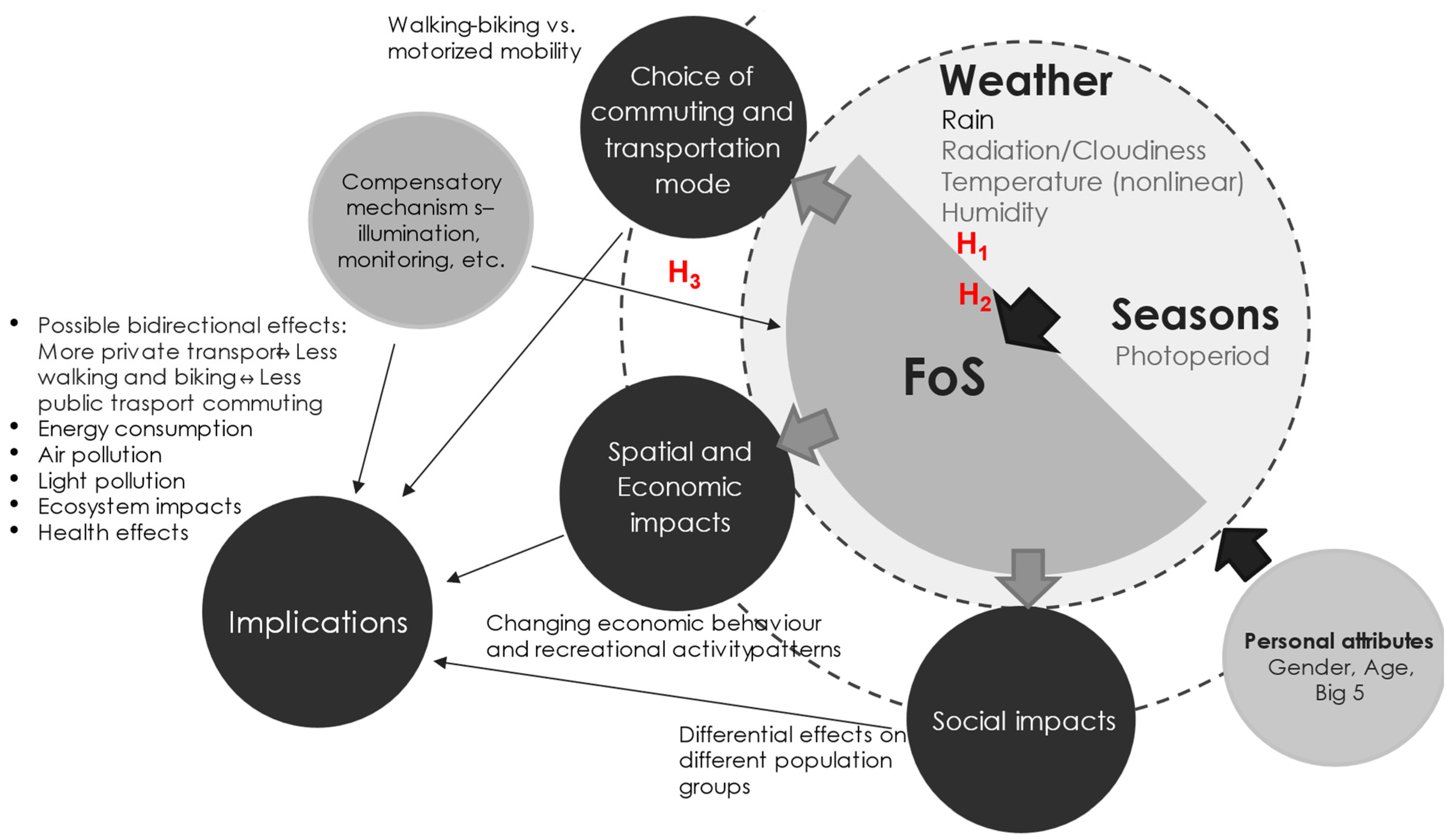
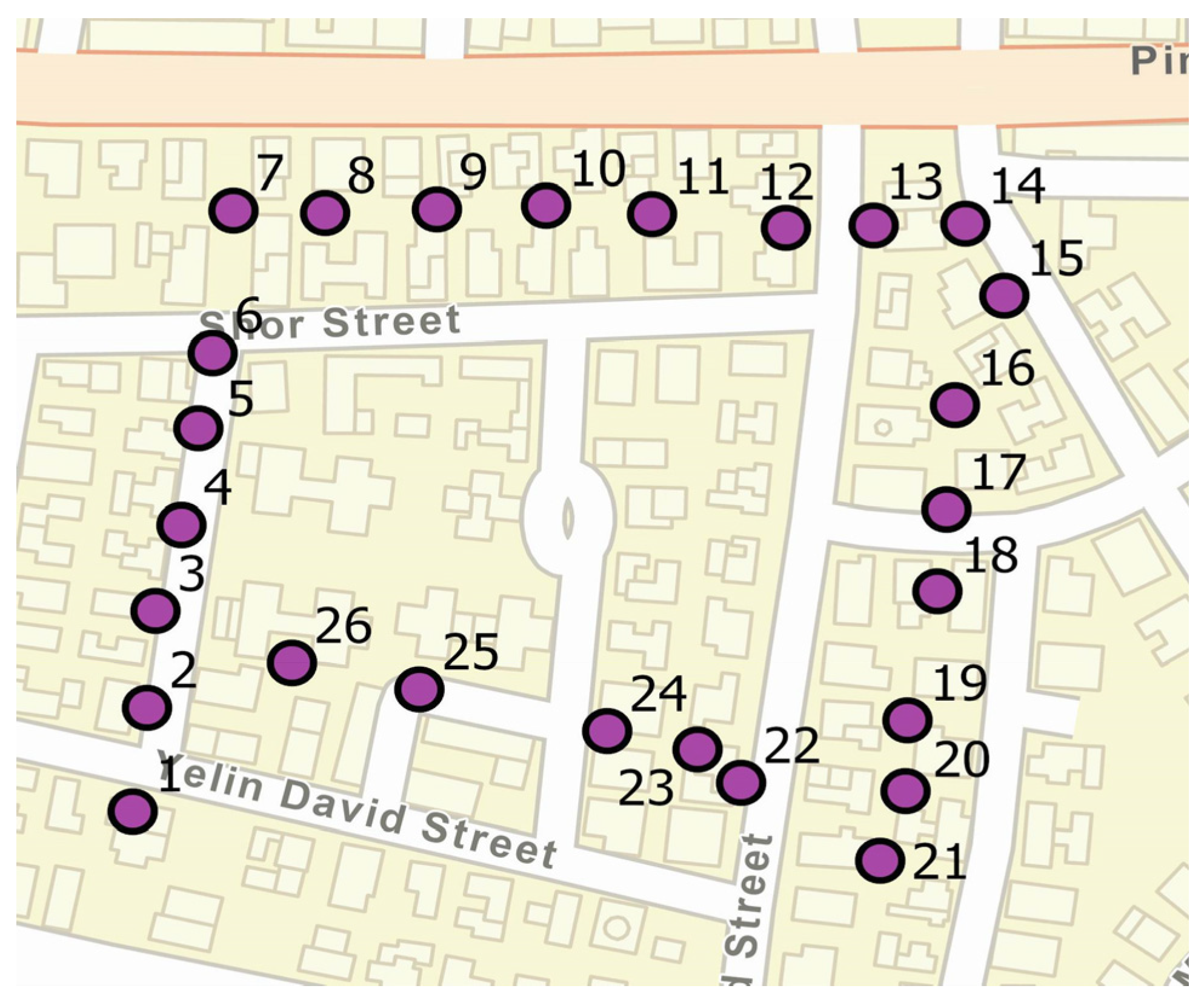
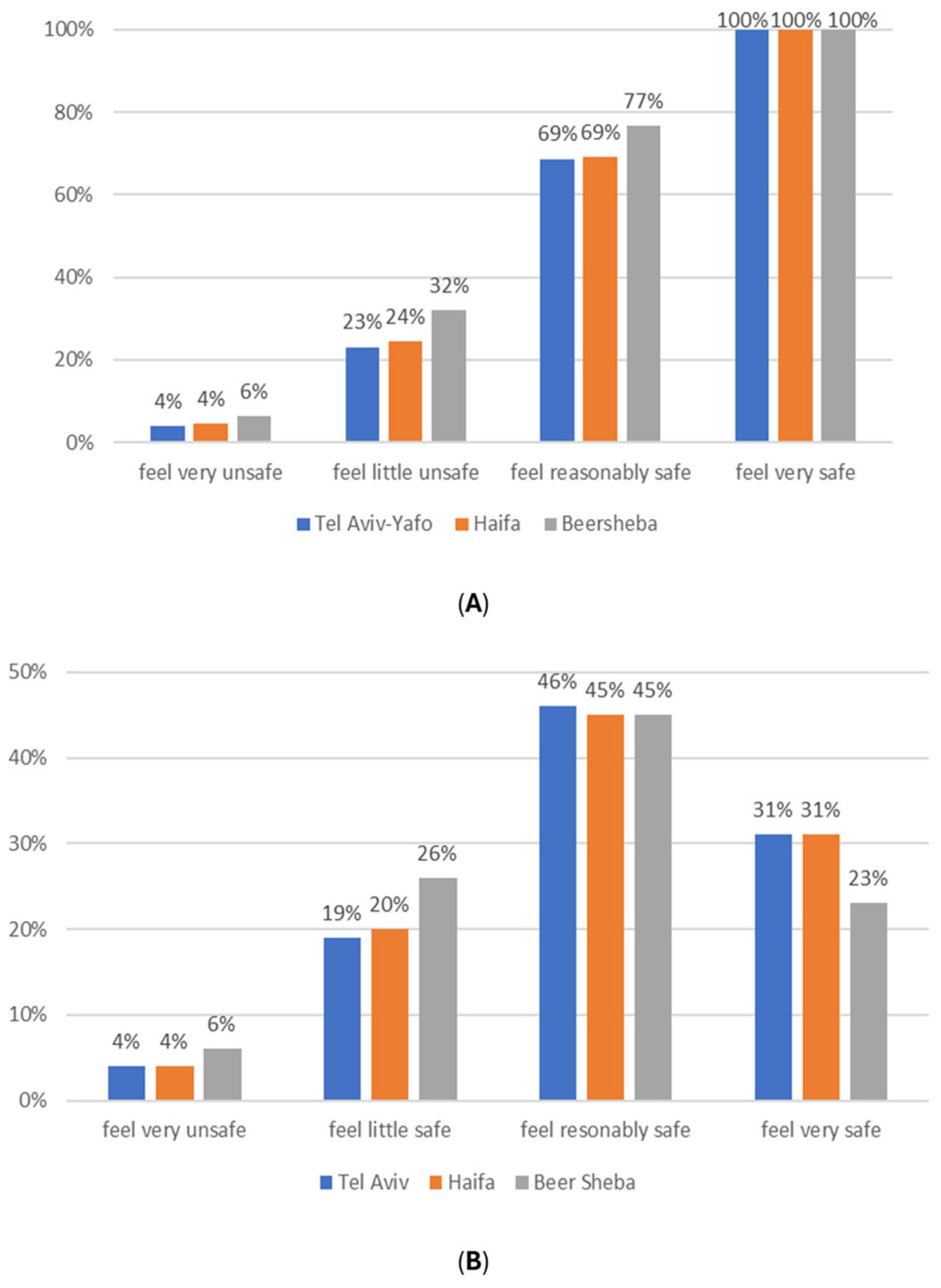

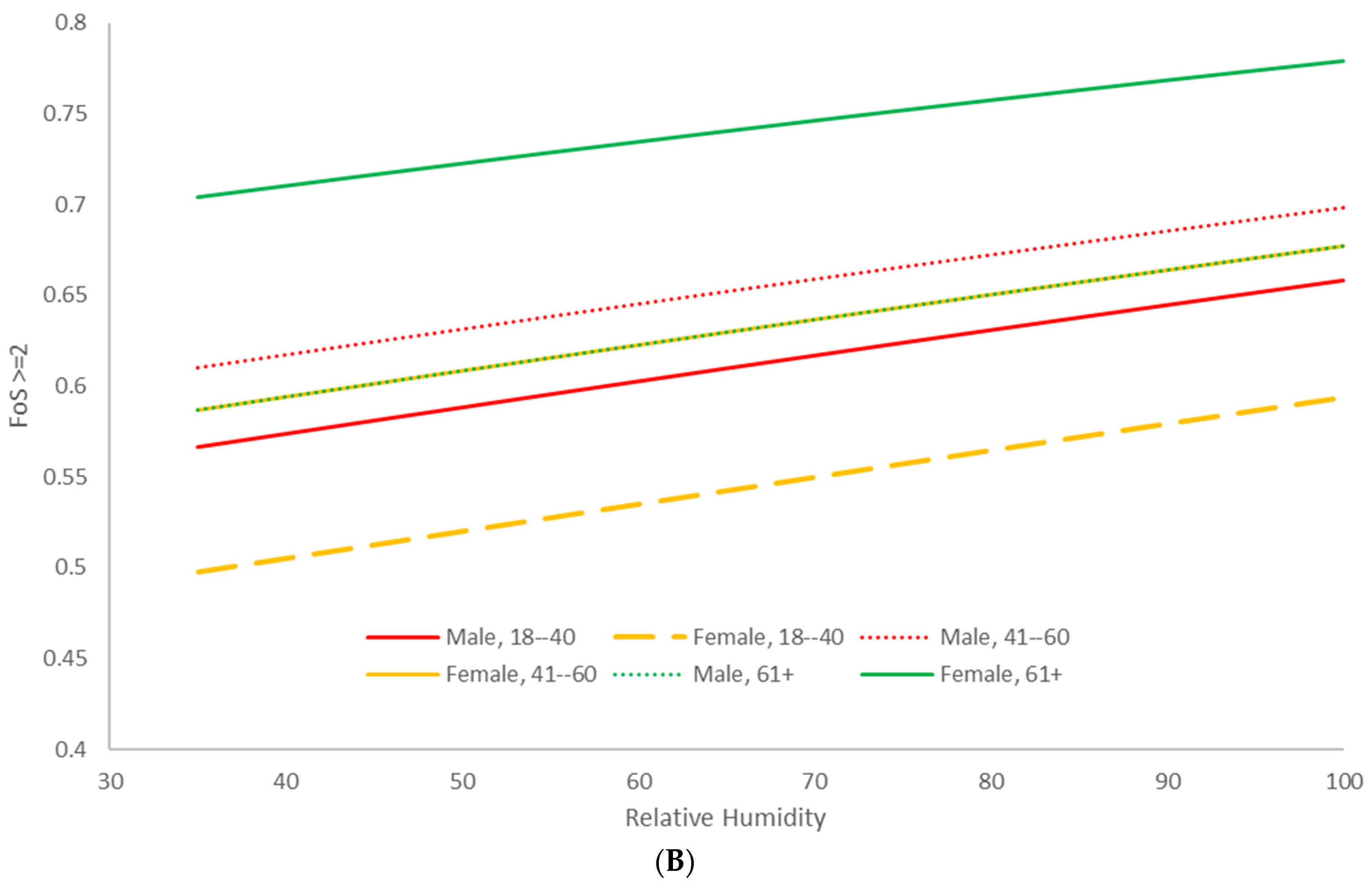
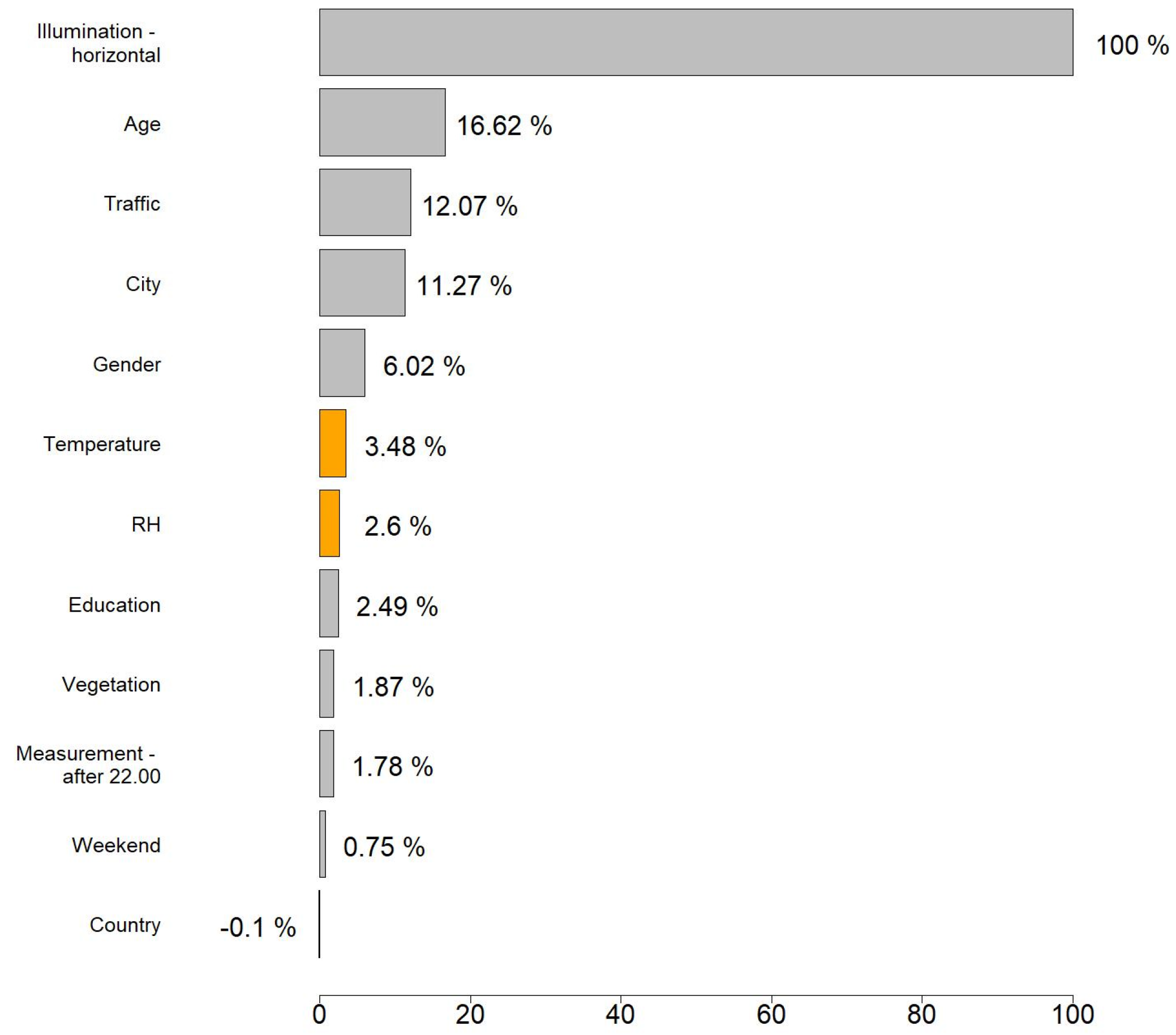
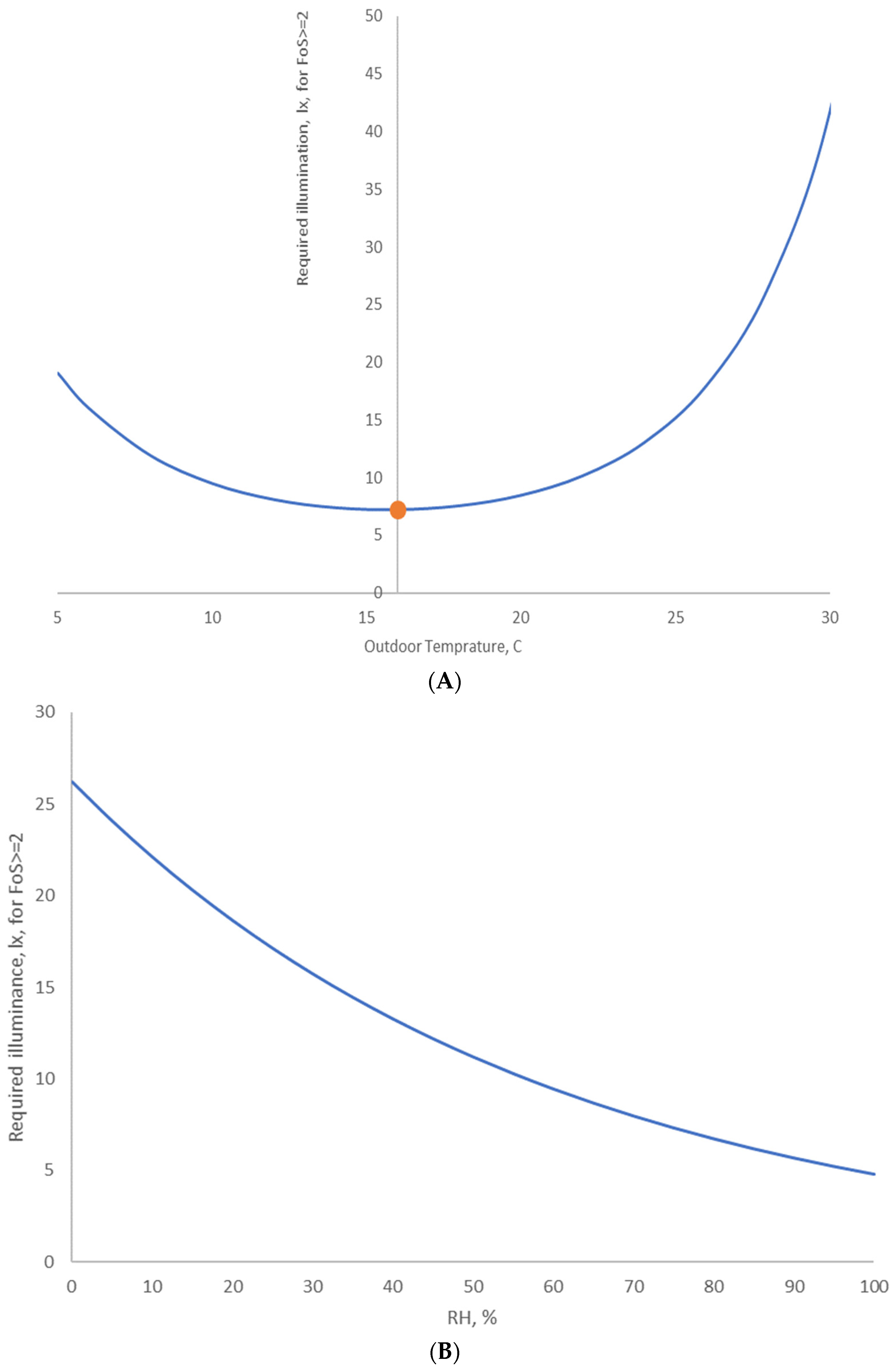
| A. Number of Observations (Discrete and Categorical Variables) | ||||
|---|---|---|---|---|
| Variable | Number of Observers or Measurements | % | Number of Observations | % |
| Feeling of safety (FoS) | 30,216 | 100.00 | ||
| • Feel very safe (FoS = 3) | - | - | 8960 | 29.65 |
| • Feel reasonably safe (FoS = 2) | - | - | 13,660 | 45.21 |
| • Feel little unsafe (FoS = 1) | - | - | 6229 | 20.62 |
| • Feel unsafe (FoS = 0) | - | - | 1367 | 4.52 |
| Location factors | 232 | 100 | 30,216 | 100 |
| City | ||||
| • Tel Aviv-Yafo (ref.) | 106 | 45.69 | 17,717 | 58.63 |
| • Haifa | 49 | 21.12 | 6549 | 21.68 |
| • Beersheba | 77 | 33.19 | 5950 | 19.69 |
| Traffic | ||||
| • Sparse traffic (ref.) | 137 | 59.05 | - | - |
| • Average traffic | 68 | 29.31 | - | - |
| • Intense traffic | 27 | 11.64 | - | - |
| Vegetation | ||||
| • No vegetation (ref.) | 97 | 41.81 | - | - |
| • Sparse vegetation | 105 | 45.26 | - | - |
| • Dense vegetation | 30 | 12.93 | - | - |
| Individual factors | 491 | 100 | 30,216 | 100 |
| Age | ||||
| • 18–40 (ref.) | 268 | 54.58 | 16,796 | 55.58 |
| • 41–60 | 179 | 36.46 | 10,336 | 34.21 |
| • 61+ | 44 | 8.96 | 3084 | 10.21 |
| Gender | ||||
| • Female (ref.) | 227 | 46.23 | 12,793 | 42.34 |
| • Male | 264 | 53.77 | 17,423 | 57.66 |
| Country of birth | ||||
| • Israel (ref.) | 421 | 85.74 | 25,811 | 85.42 |
| • Other countries | 70 | 14.26 | 4405 | 14.58 |
| Education (years of schooling) | 491 | 100 | - | - |
| Temporal factors | ||||
| Day of week | 623 | 100 | 30,216 | 100 |
| • Weekday | 411 | 65.97 | 21,662 | 71.69 |
| • Weekend | 212 | 34.03 | 8554 | 28.31 |
| Assessment time | 634 | 100 | 30,216 | 100 |
| • Before 22.00 | 421 | 66.40 | 21,763 | 72.02 |
| • After 22.00 | 213 | 33.60 | 8453 | 27.98 |
| B. Continuous variables, by city | ||||
| Variable | Mean | SD | Min | Max |
| Illuminance—horizontal (ln) | ||||
| • Tel Aviv-Yafo (ref.) | 2.11 | 1.24 | −1.66 | 4.30 |
| • Haifa | 2.27 | 1.24 | −0.51 | 4.36 |
| • Beersheba | 2.13 | 1.07 | −0.65 | 4.24 |
| • All | 2.15 | 1.21 | −1.66 | 4.36 |
| Temperature, °C | ||||
| • Tel Aviv-Yafo (ref.) | 20.22 | 4.76 | 10.20 | 29.20 |
| • Haifa | 21.59 | 4.71 | 10.80 | 28.60 |
| • Beersheba | 18.45 | 5.03 | 10.80 | 27.50 |
| • All | 20.17 | 4.91 | 10.20 | 29.20 |
| Relative humidity (RH), % | ||||
| • Tel Aviv-Yafo (ref.) | 66.86 | 13.14 | 13.80 | 93.40 |
| • Haifa | 67.54 | 14.67 | 18.30 | 96.00 |
| • Beersheba | 59.28 | 13.87 | 14.00 | 82.00 |
| • All | 65.51 | 13.98 | 13.80 | 96.00 |
| C. Categorical variables, by city | ||||
| Traffic | Sparse traffic | Average traffic | Intense traffic | Grand total |
| • Tel Aviv-Yafo | 11,986 | 2788 | 2943 | 17,717 |
| • Haifa | 3573 | 2380 | 596 | 6549 |
| • Beersheba | 2862 | 2630 | 458 | 5950 |
| • Grand total | 18,421 | 7798 | 3997 | 30,216 |
| Vegetation | No vegetation | Sparse vegetation | Dense vegetation | Grand total |
| • Tel Aviv-Yafo | 4685 | 10,907 | 2125 | 17,717 |
| • Haifa | 3866 | 2003 | 680 | 6549 |
| • Beersheba | 3106 | 1916 | 928 | 5950 |
| • Grand total | 11,657 | 14,826 | 3733 | 30,216 |
| Age | 18–40 | 41–60 | 61+ | Grand total |
| • Tel Aviv-Yafo | 8737 | 6913 | 2067 | 17,717 |
| • Haifa | 3516 | 2433 | 600 | 6549 |
| • Beersheba | 4543 | 990 | 417 | 5950 |
| • Grand total | 16,796 | 10,336 | 3084 | 30,216 |
| Country of birth | - | Israel | Other countries | Grand total |
| • Tel Aviv-Yafo | 2096 | 15,621 | 17,717 | |
| • Haifa | 1226 | 5323 | 6549 | |
| • Beersheba | 1083 | 4867 | 5950 | |
| • Grand total | 4405 | 25,811 | 30,216 | |
| Day of the week | - | Weekday | Weekend | Grand total |
| • Tel Aviv-Yafo | 12,470 | 5247 | 17,717 | |
| • Haifa | 4471 | 2078 | 6549 | |
| • Beersheba | 4721 | 1229 | 5950 | |
| • Grand total | 21,662 | 8554 | 30,216 | |
| Predictor | Model 1 | Model 2 | ||
|---|---|---|---|---|
| B | t-Value | B | t-Value | |
| Weather attributes | ||||
| temperature (°C) | 0.094 | 8.717 *** | 0.052 | 4.501 *** |
| temperature^2 | −0.003 | −9.932 *** | −1.16 × 10−3 | −3.842 *** |
| relative humidity (%) | 0.006 | 7.675 *** | 4.66 × 10−3 | 5.585 *** |
| Illumination | ||||
| Illuminance—horizontal (Ln) | 0.352 | 37.379 *** | 0.475 | 46.945 *** |
| Locational and environmental factors | ||||
| City dummies (ref. = Tel Aviv-Yafo) | ||||
| Haifa | −0.134 | −4.573 *** | - | - |
| Beersheba | −0.403 | −12.889 *** | - | - |
| Traffic density (ref. = sparse traffic) | ||||
| average traffic | 0.357 | 13.184 *** | 0.462 | 16.410 *** |
| heavy traffic | 0.370 | 10.921 *** | 0.595 | 16.254 *** |
| Vegetation (ref. = no vegetation) | ||||
| sparse vegetation | −0.069 | −2.827 *** | −0.118 | −4.697 *** |
| dense vegetation | −0.194 | −5.342 *** | −0.251 | −6.480 *** |
| Individual level factors | ||||
| Age group (ref. = 60+) | ||||
| 18–40 yo (Age1) | −0.084 | −1.766 * | - | - |
| 40–59 yo (Age2) | 0.098 | 1.940 * | - | - |
| Gender (ref. = Male) | ||||
| · Female | 0.518 | 7.134 *** | - | - |
| Interaction terms: | ||||
| · Age1 * Gender | −0.794 | −10.118 *** | ||
| · Age2 * Gender | −0.615 | −7.401 *** | ||
| Education (years of schooling) | 0.025 | 6.592 *** | - | - |
| Country of birth (ref. = Israel) | ||||
| other countries | 0.068 | 2.120 ** | - | - |
| Temporal factors | ||||
| Day of the week (ref. = weekend) | ||||
| weekday | −0.069 | −2.807 *** | 0.086 | 3.273 *** |
| Assessment time (ref. = after 22:00) | ||||
| before 22:00 | 0.135 | 5.142 *** | 0.132 | 4.746 *** |
| Intercepts | ||||
| α1 (0|1) | −1.060 | −130.606 *** | −2.003 | −22.921 *** |
| α2 (1|2) | 0.989 | 35.947 *** | 0.412 | 4.525 *** |
| α3 (2|3) | 3.090 | 99.947 *** | 3.215 | 34.453 *** |
| Number of observations | 30,216 | 30,216 | ||
| −2 log-likelihood | 34,383.080 | 28,269.040 | ||
| AIC | 68,810.170 | 57,544.070 | ||
| Predictor | Model 3 | Model 4 | ||
|---|---|---|---|---|
| B | t-Value | B | t-Value | |
| Weather attributes | ||||
| · temperature (°C)|Tel Aviv | −0.054 | −4.233 *** | 0.212 | 14.900 *** |
| · temperature^2|Tel Aviv | 4.974 × 10−4 | 1.452 ns | −5.27 × 10−3 | −13.871 *** |
| · temperature (°C)|Haifa | 0.451 | 23.578 *** | 0.083 | 4.849 *** |
| · temperature^2|Haifa | −0.011 | −21.581 *** | −1.31 × 10−3 | −2.683 *** |
| · temperature (°C)|Beersheba | 0.026 | 1.373 ns | 0.141 | 8.394 *** |
| · temperature^2|Beersheba | −0.001 | −1.182 ns | −4.78 × 10−3 | −9.884 *** |
| · relative humidity (%)|Tel Aviv | 0.231 | 2.243 ** | −0.170 | −1.610 |
| · relative humidity (%)|Haifa | 1.606 | 10.822 *** | 1.387 | 10.642 *** |
| · relative humidity (%)|Beersheba | 0.142 | 0.857 ns | 1.166 | 9.254 *** |
| Illuminance|City | ||||
| Illuminance—horizontal (Ln)|Tel Aviv | 0.361 | 30.759 *** | 0.480 | 37.808 *** |
| Illuminance—horizontal (Ln)|Haifa | 0.247 | 12.814 *** | 0.342 | 16.551 *** |
| Illuminance—horizontal (Ln)|Beersheba | 0.516 | 21.612 *** | 0.673 | 26.456 *** |
| Locational and environmental factors | ||||
| City dummies (ref. = Tel Aviv-Yafo) | ||||
| · Haifa | −5.919 | −335.223 *** | - | - |
| · Beersheba | −1.798 | −82.944 *** | - | - |
| Traffic density (ref. = sparse traffic) | ||||
| · average traffic | 0.325 | 11.880 *** | 0.426 | 14.462 *** |
| · heavy traffic | 0.388 | 11.435 *** | 0.606 | 16.483 *** |
| Vegetation (ref.= no vegetation) | ||||
| · sparse vegetation | −0.044 | −1.781 * | −0.091 | −3.426 *** |
| · dense vegetation | −0.151 | −4.119 *** | −0.200 | −5.082 *** |
| Individual level factors | ||||
| Age group (ref. = 60+) | ||||
| · 18–40 yo (Age1) | −0.075 | −1.554 ns | - | - |
| · 40–59 yo (Age2) | 0.107 | 2.099 *** | - | - |
| Gender (ref. = male) | ||||
| · female | 0.555 | 7.617 *** | - | - |
| Interaction terms: | ||||
| · Age1 * Gender | −0.845 | −10.714 *** | ||
| · Age2 * Gender | −0.660 | −7.903 *** | ||
| Education (years of schooling) | 0.026 | 6.789 *** | - | - |
| Country of birth (ref. = Israel) | ||||
| · other countries | 0.059 | 1.824 * | - | - |
| Temporal factors | ||||
| Day of the week (ref. = weekend) | ||||
| · weekday | −0.084 | −3.440 *** | 0.104 | 3.740 *** |
| Assessment time (ref. = after 22:00) | ||||
| · before 22:00 | 0.140 | 5.332 *** | 0.142 | 4.721 *** |
| Intercepts | ||||
| · α1 (0|1) | −2.816 | −82.186 *** | −0.640 | −5.942 *** |
| · α2 (1|2) | −0.755 | −17.816 *** | 1.789 | 16.243 *** |
| · α3 (2|3) | 1.356 | 30.484 *** | 4.601 | 41.134 *** |
| Number of observations | 30,216 | 30,216 | ||
| −2 log-likelihood | 34,275.950 | 28,199.680 | ||
| AIC | 68,611.910 | 57,421.350 | ||
Disclaimer/Publisher’s Note: The statements, opinions and data contained in all publications are solely those of the individual author(s) and contributor(s) and not of MDPI and/or the editor(s). MDPI and/or the editor(s) disclaim responsibility for any injury to people or property resulting from any ideas, methods, instructions or products referred to in the content. |
© 2024 by the authors. Licensee MDPI, Basel, Switzerland. This article is an open access article distributed under the terms and conditions of the Creative Commons Attribution (CC BY) license (https://creativecommons.org/licenses/by/4.0/).
Share and Cite
Saad, R.; Portnov, B.A.; Kliger, D. The Feeling of Safety by Pedestrians at Night: An Overlooked Aspect of Climate Change? Sustainability 2024, 16, 10402. https://doi.org/10.3390/su162310402
Saad R, Portnov BA, Kliger D. The Feeling of Safety by Pedestrians at Night: An Overlooked Aspect of Climate Change? Sustainability. 2024; 16(23):10402. https://doi.org/10.3390/su162310402
Chicago/Turabian StyleSaad, Rami, Boris A. Portnov, and Doron Kliger. 2024. "The Feeling of Safety by Pedestrians at Night: An Overlooked Aspect of Climate Change?" Sustainability 16, no. 23: 10402. https://doi.org/10.3390/su162310402
APA StyleSaad, R., Portnov, B. A., & Kliger, D. (2024). The Feeling of Safety by Pedestrians at Night: An Overlooked Aspect of Climate Change? Sustainability, 16(23), 10402. https://doi.org/10.3390/su162310402







